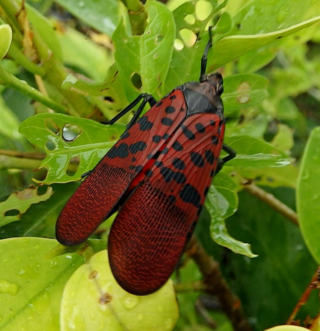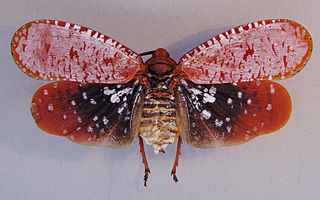
Ailanthus is a genus of trees belonging to the family Simaroubaceae, in the order Sapindales. The genus is native from east Asia south to northern Australasia.

Bifenthrin is a pyrethroid insecticide. It is widely used against ant infestations.

Methyl salicylate (oil of wintergreen or wintergreen oil) is an organic compound with the formula C8H8O3. It is the methyl ester of salicylic acid. It is a colorless, viscous liquid with a sweet, fruity odor reminiscent of root beer, but often associatively called "minty", as it is an ingredient in mint candies. It is produced by many species of plants, particularly wintergreens. It is also produced synthetically, used as a fragrance and as a flavoring agent.

Ailanthus altissima, commonly known as tree of heaven, ailanthus, varnish tree, or in Chinese as chouchun, is a deciduous tree in the family Simaroubaceae. It is native to northeast and central China, and Taiwan. Unlike other members of the genus Ailanthus, it is found in temperate climates rather than the tropics.

The family Fulgoridae is a large group of hemipteran insects, especially abundant and diverse in the tropics, containing over 125 genera worldwide. They are mostly of moderate to large size, many with a superficial resemblance to Lepidoptera due to their brilliant and varied coloration. Various genera and species are sometimes referred to as lanternflies or lanthorn flies, though they do not emit light.

The large-spotted civet is a viverrid native to Southeast Asia that is listed as Endangered on the IUCN Red List.

The Finger Lakes AVA is an American Viticultural Area located in Upstate New York, south of Lake Ontario. It was established in 1982 and encompasses the eleven Finger Lakes, but the area around Canandaigua, Keuka, Seneca, and Cayuga Lakes contain the vast majority of vineyard plantings in the AVA. Cayuga and Seneca Lakes each have their own American Viticultural Areas completely contained within the Finger Lakes AVA. The Finger Lakes AVA includes 11,000 acres (4,452 ha) of vineyards and is the largest wine-producing region in New York State.

The subfamily Aphaeninae is a group of hemipteran insects, especially abundant and diverse in the tropics. They belong to the Fulgoridae (fulgorids), though they are not among the better-known members of that family that are called "lantern bugs" or "lanternflies". In 2009, the first molecular analysis of the Fulgoridae challenged the existing structure of eight currently recognized subfamilies and eleven tribes.

Dinotefuran is an insecticide of the neonicotinoid class developed by Mitsui Chemicals for control of insect pests such as aphids, whiteflies, thrips, leafhoppers, leafminers, sawflies, mole cricket, white grubs, lacebugs, billbugs, beetles, mealybugs, and cockroaches on leafy vegetables, in residential and commercial buildings, and for professional turf management. Its mechanism of action involves disruption of the insect's nervous system by inhibiting nicotinic acetylcholine receptors. In order to avoid harming beneficial insects such as bees, it should not be applied during bloom.

The spotted lanternfly is a planthopper indigenous to parts of China and Vietnam. It has spread invasively to Japan, South Korea, and the United States. Its preferred host is tree of heaven, but it infests economically significant plants including soybean, grapes, stone fruits, and Malus spp. In its native habitat, L. delicatula populations are kept in check by parasitic wasps.

Lycorma is a genus of planthoppers native to Asia. The first species within the genus was described by Frederick William Hope in 1843 and the genus was formally established by Carl Stål in 1863.
Penthicodes pulchellus is a species of planthoppers in the subfamily Aphaeninae (Fulgoridae): found in southern India, Indo-China and Malesia. It belongs to the subgenus EreosomaKirkaldy, 1906. The genus name was formerly treated as feminine, but in 2022 it was revised to masculine in accordance with ICZN Article 30.1.4.4, changing the spelling of this species' name from pulchella to pulchellus.
Ann E. Hajek is an American entomologist with a focus in insect-microbe interactions. She is a Professor of Entomology at Cornell University.
Anastatus orientalis is a species of parasitic wasp which preys on Lycorma lanternfly eggs. Females live significantly longer than males, over ten weeks compared to the male lifespan of three weeks.

Lycorma imperialis is a planthopper indigenous to parts of China and Indo-Malaysia. L. imperialis was originally discovered in 1846 by Adam White and has one recognized non-nominate subspecies, L. i. punicea. L. imperialis has undergone a number of reclassifications since its discovery and is one of four species in the genus Lycorma. L. imperialis follows a hemimetabolous life cycle and will undergo a series of nymphal stages (instars) before maturing to an adult.

Ooencyrtus kuvanae is a species of chalcid wasp. It was introduced to North America in 1908 to control Lymantria moths. In North America, it has become an active parasitoid of the invasive spotted lanternfly.

Lycorma olivacea is a planthopper indigenous to Taiwan.

Lycorma meliae is a planthopper indigenous to Taiwan.

Aphaena submaculata is a species of planthoppers in the sub-family Aphaeninae of Fulgoridae. Species are distributed from eastern India, Indo-China, China and Malesia.















